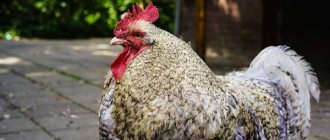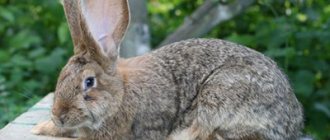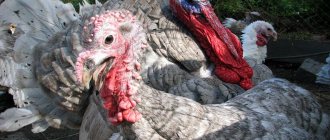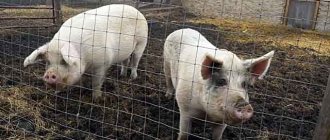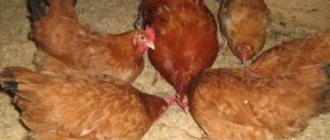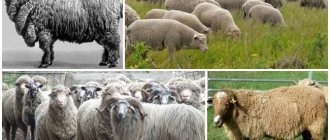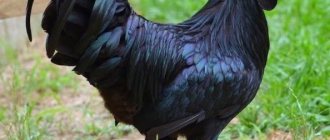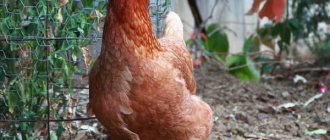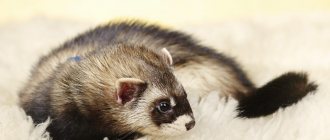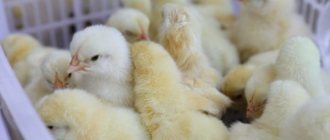Humanity domesticated pigs more than 7,000 years ago, and since then pig farming has become an integral part of animal husbandry. Among the variety of pig breeds, the black pig is of particular interest to breeders. Animals with this coloring are found in different breeds. Their advantage is their unpretentiousness in maintenance and nutrition. Before you start breeding representatives of this group, you need to learn more about the individual characteristics and traits of common breeds of black pigs.
Large black
One of the “black” breeds most common in Russia. Obtained at the beginning of the 19th century in England (where it is called Cornish). As a result of crossing English long-eared, Chinese black and Neapolitan pigs, it was possible to breed large meat-and-fat animals.
Large black pigs are distinguished by multiple births (on average 10-12 piglets per 1 farrow) and high rates of live weight gain
The weight of males reaches 300-400 kg, females are usually 100 kg lighter . Individuals of this breed have a body in the shape of an elongated barrel, a small head, a powerful neck and an arched back. The legs are strong, with well-formed hams. The head is light. The ears are large, directed forward and drooping over the eyes. The skin is black, and in adult pigs it is often folded. The bristles are black.
Fertility is considered high: in one farrow the sow gives birth to 10-12 babies , each of which weighs at least 100 kg by six months. When slaughtered, the carcass yields up to 52% meat and about 40% lard .
Representatives of the breed are unpretentious and omnivorous, can easily tolerate heat, and can be kept on semi-range during the warm season. Breeding boars of this variety are actively used for crossing with females of other breeds (large white, landrace, etc.), as well as with local crossbred pigs to improve the constitution and meat characteristics of the offspring.
Purebred boars are actively used in breeding work to produce offspring with improved meat characteristics
In our country, large black pigs are bred mainly in Tatarstan, Tver, Samara and Saratov regions, as well as in the Krasnodar Territory. Since 1993, the breed has been registered in the State Register as approved for cultivation in all regions of Russia.
General characteristics of the group
Black pigs, like their light-skinned counterparts, are divided into three categories:
- Meat. This group includes animals in which the deposition of fat reserves proceeds slowly. Meat pigs are distinguished by well-developed muscles, a long build and tasty, lean meat.
- Greasy. Animals of this group, on the contrary, rapidly accumulate fat reserves. The front part of greasy pigs is heavier than the back part.
- Meat-tallow is a universal group, whose representatives accumulate both meat and lard. At the same time, the quality characteristics of the products are at a high level.
Black pigs are one of the most popular and widespread groups, whose representatives are valued for their unpretentiousness and high quality products. There are several pedigrees that fall into this category, each with individual strengths and weaknesses.
Kemerovo
The breed was obtained in the middle of the 20th century by employees of Kemerovo and Novosibirsk research institutes. During breeding, male Large White pigs and local crossbred queens were used, which were distinguished by good health and early maturity. The first Kemerovo pigs were meat-fat, but later scientists developed a purely meat variety (“KM-1 line”). Kemerovo pigs were included in the State Register in 1993.
The color of Kemerovo pigs is distinguished by the presence of white spots on the face, lower limbs and tip of the tail.
Males weigh up to 350 kg with a body length of up to 180 cm, females are 100-150 kg lighter and 10 cm shorter. Color black or dark grey. It is characterized by the presence of small white spots on the forehead, tip of the tail and lower legs. The body is elongated, the chest and back are wide, the legs are stocky. The head is medium, the snout is “upturned”, the ears are small and erect. The bristles are thick and long. Pigs are calm, obedient, and undemanding to indoor temperature conditions. Among the disadvantages, it is worth noting some sensitivity to eating disorders.
A sow gives birth to up to 12 babies per farrow. At the time of weaning, they usually grow to 20-25 kg. When fattened according to the meat type, by six months black piglets weigh 100-120 kg . In this case, the thickness of the spike on the back does not exceed 25 mm.
The animals were bred for the difficult conditions of the northwestern and northern regions of our country; they have endurance and adaptability to the harsh continental climate. The breed is very popular in the Sakhalin, Chita and Kemerovo regions, Krasnoyarsk Territory, as well as in the northern regions of Kazakhstan.
Hampshire
The breed was developed in the USA by crossing breeding males imported from Great Britain with local females. According to the description and characteristics, Hampshires are typical meat (bacon) pigs. They are distinguished by their strong build and fairly heavy weight ( boars up to 300 kg, and pigs 190-220 kg ).
Hampshire pigs have a characteristic color - black with a light stripe encircling the body in the area of the forelimbs
The color is black, with the exception of the front legs and a narrow transverse stripe running across the chest and shoulder blade area (these areas are white). The body is elongated, the legs are thick and short. The back is more massive than the front. The head is elongated, the snout is straight, the ears are small and erect. Animals have good health, are unpretentious in food and undemanding to living conditions. Unfortunately, Hampshires are extremely sensitive to stress: any anxiety greatly reduces the rate of weight gain.
Hampshire females are infertile (no more than 8 babies per farrow ). The queens usually have enough milk; prolapse occurs extremely rarely. Until the age of seven months, piglets grow relatively slowly, but older young animals actively form excellent “marbled” meat, which has a very good taste. The productive yield from the carcass is 50-70%.
Due to their high sensitivity to stress, low fertility and relatively low productivity, Hampshire pigs are not often found on farms. However, breeding boars are successfully crossed with dams of other breeds to improve the quality of the offspring.
Advantages and disadvantages
The most characteristic advantages of black breeds of pigs in the context of breeding on farms include the following criteria:
- large build;
- high fertility of females and care for offspring;
- lean delicacy meat with a large slaughter yield;
- newborn piglets have a high survival rate;
- young animals quickly gain meat mass;
- you can cross and breed hybrid breeds;
- capable of grazing and feeding;
- unpretentious to climate change.
Characteristic disadvantages should also be indicated:
- prone to obesity;
- skin gathered into folds is prone to various diseases due to the proliferation of microbes in the cavity of the folds;
- weak muscle corset in the posterior region.
Comparative table of characteristics of pig breeds with black color:
| Breed name | Body dimensions, m | Weight, kg | Daily weight gain, g | Meat, % | Salo, % |
| Large black | 1,6 – 1,8 | 240 – 350 | 750 | From 57 | From 33 |
| Vietnamese pot-bellied | 1,2 – 1,4 | 80 – 130 | 900 | From 75 | Up to 25 |
| Berkshire | 1,5 – 1,7 | 200 – 250 | 800 | 80 | 20 |
| Hampshire | 1,4 – 1,7 | 210 – 240 | 750 | 75 | 25 |
| Meishan | 1,4 – 1,7 | 180 – 240 | 650 | 65 | 35 |
| Iberian | 1,3 – 1,5 | 140 – 170 | 800 | 60 | 40 |
| Guinean | 1,2 – 1,4 | 140 – 160 | 750 (high fat content) | 30 | 70 |
| Belarusian Pied | 1,6 – 1,8 | 210 – 320 | 700 –800 | 75 | 25 |
The main comparative characteristics were presented regarding the dimensions and gastronomic feasibility of breeding black breed pigs. We deliberately did not include mini pigs in the comparison table, since they have mainly decorative use as pets.
Berkshire
A very famous breed, obtained in the middle of the 19th century in England (Berkshire). It has a high ability to transmit to offspring the qualities that interest livestock breeders. Therefore, Berkshires are actively used to breed other varieties of pigs. In particular, their genetic material was used to obtain such breeds as Livenskaya, Kemerovo, Mirgorodskaya, North Caucasian and many others.
Berkshire pigs have been used in the development of many popular breeds
Animals of meat or meat-fat type, depending on the feeding regime. Piglets that are fattened for meat reach a slaughter weight of 100 kg by six months. Sows weigh 220-240 kg, boars - 300-350 kg . Purebred individuals have a cylindrical body and short legs. The back is wide, the neck is light. The head is medium, the snout is “upturned”, the ears are small, erect, shaggy. The color is black with characteristic small white spots on the ends of the legs, muzzle and tail (as in the photo). The bristles are long and thick.
Berkshires are unpretentious in food and undemanding to living conditions. The main disadvantage is their low fertility: 6-9 babies per farrowing . Therefore, breeding is carried out mainly by breeding farms in order to obtain purebred producers.
Peculiarities
Black pigs are also divided into three large groups:
To date, several breeds of these animals have been bred, with such an unusual color for their group. But they all share a common characteristic:
- the ears are quite large, drooping, while the head itself is small in size;
- the back part of such animals seems to hang down against the background of the rest of the carcass;
- The body of black pigs of any breed is always elongated, and the legs are large and end where the hocks begin;
- the body is large, muscular, all muscle groups are well developed;
- the live weight of an adult mature boar can reach 350 kg, females – 250 kg;
- the chest of these animals is powerful and wide;
- the average body length can reach 175 cm;
- There are skin folds on the legs.
At the same time, it is black pigs that those people who have decided to try their hand at pig farming for the first time in their lives should start breeding. Animals grow quickly, gain weight well, and some breeds are less demanding to care for compared to their pink relatives.
Meishan
A widespread breed of sebaceous breed, known for several centuries. Bred in China (in the Meishan/Meishan district).
Meishans are distinguished by their precocity and multiple births: sows, starting from 3 months of age, can bear 15-16 piglets
The weight of an adult is about 250 kg. The body is massive, thick, with a concave back and saggy belly. Legs are short and powerful. The head is wide, with a shortened and “upturned” snout. The ears are wide and long (up to 30 cm), hanging over the eyes. The skin is wrinkled on the body and head (there are numerous folds on the forehead, snout and around the eyes). The skin is black, the snout and ends of the legs are pink. The bristles are long but sparse. Meishans are easy to keep, omnivorous and highly resistant to disease.
Females are incredibly fertile (15-16 babies per farrow) and have a high milk production. Young pigs are able to piglet from the age of three months. The disadvantage of the breed is the slow growth of young animals. Piglets reach slaughter weight of 170 kg at 8 months. Up to 45% of the yield comes from lard (the thickness of the lard on the back is 35 mm). Pigs of this breed have enlarged internal organs (liver, heart, kidneys). The delicate taste of meat, lard and liver of meishan is highly appreciated by lovers, especially in Asian countries.
Rare breeds
Such less common breeds as Guinea, Black Iberian (the famous jamon is made from their meat in Spain), as well as Italian Nero di Parma pigs also have black skin and bristles. The population of the last two varieties became extremely small by the middle of the 20th century. Now livestock breeders are actively engaged in their restoration and reproduction.
In the photo - Guinea pigs (left) and Italian Nero di Parma
In the photo - pigs of the Black Iberian breed
In addition, black color is characteristic of Vietnamese pot-bellied and Mangalitsa pigs, the breeding features of which can be learned from the articles posted on our website.
What to feed?
The pig's stomach is single-chamber, and therefore it cannot withstand the load in the form of food with a lot of fiber. Veterinarians, professional livestock breeders and ordinary owners of black pigs note that it is best to feed animals with ready-made mixed feed, which is available for sale. It is better to give them homemade feed mixtures in wet form.
When using ready-made feeds, they should be given only with clean water, which should always be freely available to animals.
If black pigs eat homemade feed mixtures, then the food must necessarily include:
- mineral and vitamin supplements;
- cake and chalk;
- salt;
- food waste;
- boiled and fresh fruits and vegetables;
- pea flour and grain;
- potato.
In this case, it is necessary to study in detail the recommendations of veterinarians on the proper feeding of each breed of black pigs and create a diet based on them.
Feedback from livestock farmers
Irina, 49 years old, Saratov region
I keep large black breed sows. The litter is 11-12 pieces per farrowing, almost all of them survive, and they fatten up well. Pigs tolerate heat well (which is important in our climate) and are not fussy with food. But the pigsty needs to be insulated for the winter: we have strong winds, and these pigs are afraid of hypothermia and drafts. Everything else suits me. Good, reliable breed.
Ivan, 55 years old, Bugulma
I have crossbred sows (Landrace-Duroc). For several years now I have been bringing large black sperm for them for AI. Judging by the offspring, this option is much preferable to crossing with our local males. The piglets do not get sick, they gain weight better, and the meat during fattening turns out to be less fatty. I want to have my own boar, but I’m not sure yet: a purebred sire from a breeding farm will be very expensive.
Natalya, 51 years old, Chita
Every year I take in Kemerovo breed piglets for fattening. They are very successful animals for our area: they are not afraid of cold weather and there are no problems with keeping them. The only drawback of “purebreds” is their high demands on feed. It is necessary to carefully maintain a balanced and calorie diet, otherwise they grow slowly and the meat turns out to be of poor quality (hard or greasy). Crossbred piglets are less capricious and easier to feed.
Breeding
Puberty in black pigs occurs no earlier than 6 months after birth and when their body weight is 100 kg. Only the strongest, strongest and healthiest animals are selected for coating.
Before immediate farrowing, the queens can be kept in a common pen, but 1-2 days before the piglets are born, they are transferred to a separate enclosure with a temperature of more than +30 degrees and a red lighting lamp. The farrowing area and the animals' rookery must be covered with ordinary straw.
Winter is considered the best time of year for reproduction, and bearing offspring on average takes up to 120 days.
At the first signs of pregnancy, the diet of the uterus is enriched with various vitamin and mineral complexes. Re-mating of pigs can be carried out after six months, but provided that the animal has recovered well and the last time there were no problems during farrowing.
During the first week of life, new piglets must be vaccinated - this way the percentage of their death in the future is reduced to almost zero . A distinctive feature of these animals is a well-developed instinct of motherhood, so human intervention in the process of farrowing and raising young pigs is practically minimal.
Raising black pigs is simple, fun, and most importantly, profitable. Knowing the characteristics of these animals and following the recommendations for raising them, anyone can be convinced of this.
You can learn more about breeding black pigs from the following video.
All rights reserved, 14+
The use of any materials without our prior written consent is prohibited.
